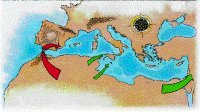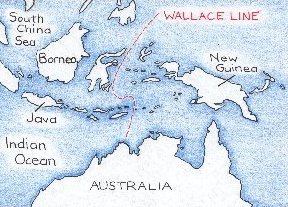 photo courtesy "Outthere" |
In the south of Spain hominid fossils and stone tools dating 1 - 1.5 Ma have been found
near the village of Orce and city of Muricia. The problem has been explaining how they got there
in the first place. The graphic on the left shows three possible routes. |
|
One idea suggests that they migrated through the Middle East, another
that they went via Malta, Sicily to Calabria in the south of Italy (Tobias 1998). These both seem
unlikely as they would have had quite vast distances to travel and they would have had to
cross the Pyrenees. Another possiblity, is that they swam through what is now the Strait of
Gibraltar (Tobias 1998). At that time, there was a sea level lowstand and the Strait would
have had previously submerged islands dotting the way and providing rest spots. The greatest distance
would have been about 5 km (Tobias 1998). If we consider some of the modern distance swimmers,
this is well within human capabilities, and is after all, the shortest route.
|
|

Redrawn from "Vanishing Worlds" by R. Lemon |
Another mystery is how Homo erectus arrived on the lsland of Flores of the coast of Java about 900,000 years ago. The crossing would have involved travelling over about 19 km of deep ocean channel, thereby crossing the Wallace Line. Fossil remains are found there along with those of an extinct member of the elephant family, Stegodon. It has never been connected to any mainland even in the lowest of sea level falls. So, one must ask: How did they get there? |
| It is not difficult to envision early hominids, and then our own genus, Homo walking (or swimming) along coastlines and rivers, thus populating the globe. If they were swimmers, and divers, it would only serve to drive them on, in the search for food as populations rise and the climate changes (Tobias 1998). | |